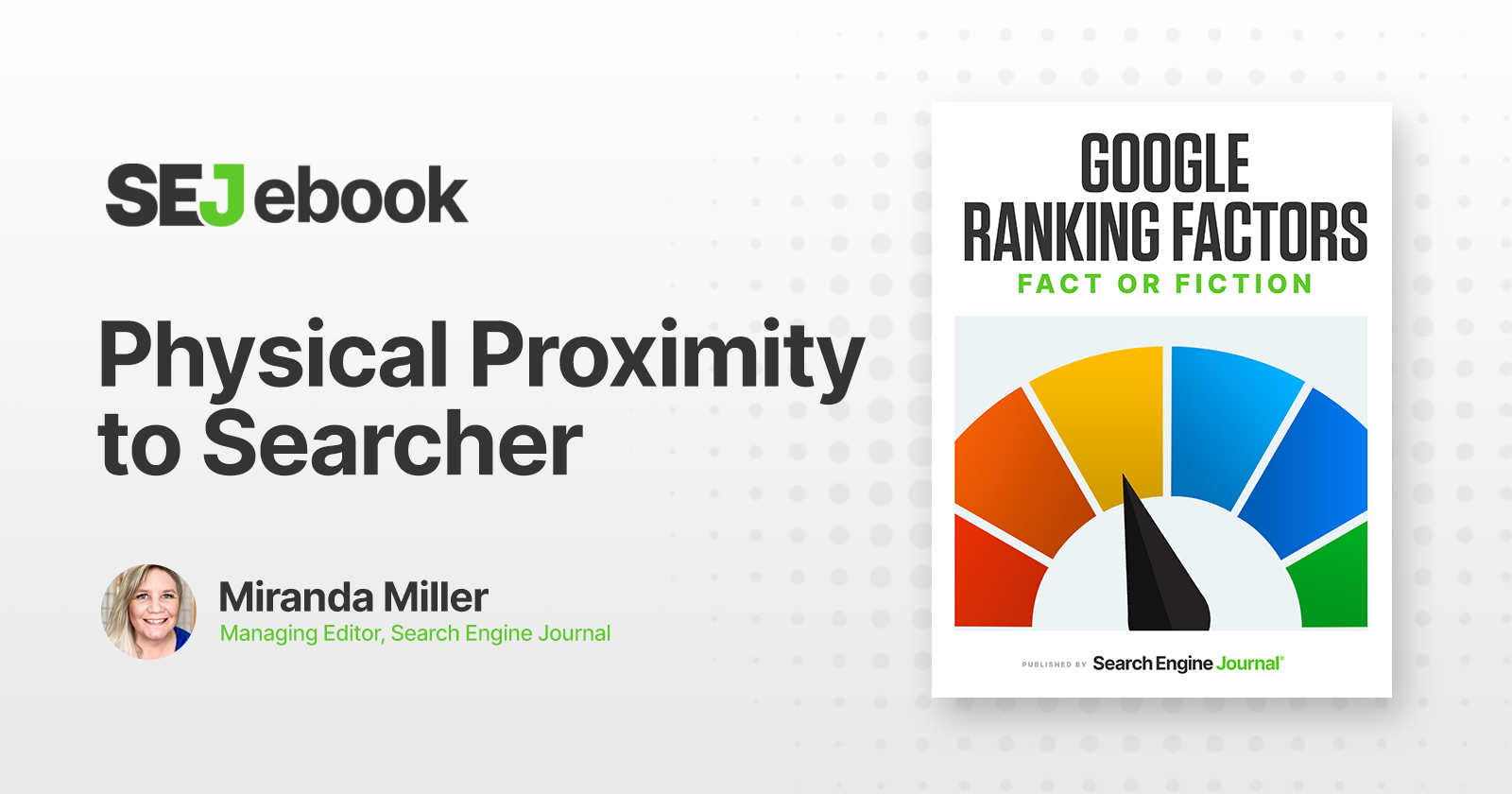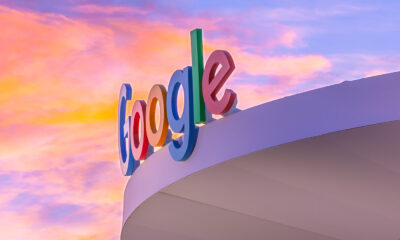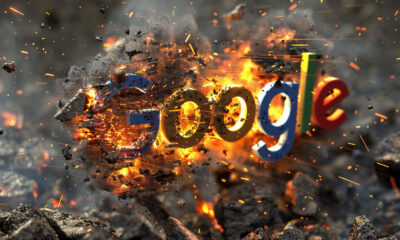SEO
Is It A Google Ranking Factor?

Close to a third of all Google searches have local intent – that is, the searcher is looking for something nearby or located in a specific area.
Often (but now always) when Google determines there is local intent, it will display top local results in a Map Pack at the top of the search results.
Businesses can appear in organic search results for queries with local intent, too.
Does how physically close the searcher is to the business impact rankings? Let’s see.
The Claim: Physical Proximity To Searcher Is A Ranking Factor
The idea here is that the distance between a physical location of the business and a searcher is a key ranking factor in local search.
The Evidence For Physical Proximity As A Ranking Factor
The searcher’s proximity to the place of business fell from #1 to #3 in Moz’s industry survey-based list of local search ranking factors in 2020.
This isn’t just a commonly held belief among SEO professionals, though.
Google flat out tells us that proximity is one of the three big factors in determining local search ranking:
“Local results are based primarily on relevance, distance, and prominence. A combination of these factors helps us find the best match for your search.
“Distance considers how far each potential search result is from the location term used in a search. If a user doesn’t specify a location in their search, we’ll calculate distance based on what we do know about their location.”
Why would Google show someone a list of pizza shops in Toronto, Canada, if they were wandering the streets of Medellin, Colombia, looking for a slice?
The big question for local SEO pros and business owners is, how do you make your location is clear to Google to ensure you appear in relevant search results?
There are a few concrete ways:
- Ensure citations (local listings) are accurate and that your business appears where people are searching for local products, services, etc.
- Claim and verify your Google My Business listing.
- Get your Google Maps API Key and optimize for Places and Routes to provide searchers a more immersive, richer experience.
- For Service Area Businesses, ensure that your profile has been set up correctly so you aren’t violating Google’s guidelines for representing the business correctly.
Demonstrating Proximity Without Physical Closeness
Beyond that, you can help Google understand the context of your location for relevant local queries and also improve your prospective customers’ experience with content optimizations.
For example, Google may be aware of your location’s map pin and understand that your location is at the crossroads of First Ave and Lyon St S in Ottawa.
Google knows this neighborhood is called The Glebe, so you’re already optimizing for searches like [restaurants in the glebe] and [dinner nearby] if the searcher is close to your physical location by virtue of having a verified GMB profile and accurate citations.
But – to borrow a few examples from sports – what about [dinner before the Jay’s game]?
Or how about [senators game dinner]?
I’m nowhere near the cities where these two teams play, and the query doesn’t have enough local intent to draw a MapPack.
But maybe I’m heading there tomorrow.
So who’s going to help me find dinner?
The first restaurant I find in the top 10 organic Google results for the Senators example isn’t even a website or local listing; it’s a Facebook post:
 Screenshot from search for [senators game dinner], Google, February 2022
Screenshot from search for [senators game dinner], Google, February 2022It’s a smart play to talk about what’s going on locally in your blog posts, GMB posts, social media, etc.
Here’s another example of demonstrating proximity to the searcher’s need when you may not be physically closest to the searcher at the time of the query, yet you’re physically close to the need:
 Screenshot from search for [panthers game and dinner], Google, February 2022
Screenshot from search for [panthers game and dinner], Google, February 2022The restaurant, OSSO, is using video to appear in position zero search results for this locally relevant query even though I’m currently 1,550 miles away.
If you want to get in front of searchers who are making plans but not yet in the immediate vicinity, create locally relevant content.
Physical Proximity To Searcher: Our Verdict

Yes, Google uses proximity/distance as a search ranking signal.
And it’s important that you don’t simply leave it to Google to surface your business only where the searcher expressly uses a location term or Google can tell where they are.
Mention local organizations, sports teams, neighborhoods, or activities in your content so Google has more ways to tell when you’re physically close to the searcher’s need.
Think of your customer personas and the problems you may be able to solve for different types of people.
Make sure you’re incorporating local information into your content where it makes sense so Google can tell you meet any local intent.
Featured Image: Robin Biong/Search Engine Journal
SEO
Google Declares It The “Gemini Era” As Revenue Grows 15%

Alphabet Inc., Google’s parent company, announced its first quarter 2024 financial results today.
While Google reported double-digit growth in key revenue areas, the focus was on its AI developments, dubbed the “Gemini era” by CEO Sundar Pichai.
The Numbers: 15% Revenue Growth, Operating Margins Expand
Alphabet reported Q1 revenues of $80.5 billion, a 15% increase year-over-year, exceeding Wall Street’s projections.
Net income was $23.7 billion, with diluted earnings per share of $1.89. Operating margins expanded to 32%, up from 25% in the prior year.
Ruth Porat, Alphabet’s President and CFO, stated:
“Our strong financial results reflect revenue strength across the company and ongoing efforts to durably reengineer our cost base.”
Google’s core advertising units, such as Search and YouTube, drove growth. Google advertising revenues hit $61.7 billion for the quarter.
The Cloud division also maintained momentum, with revenues of $9.6 billion, up 28% year-over-year.
Pichai highlighted that YouTube and Cloud are expected to exit 2024 at a combined $100 billion annual revenue run rate.
Generative AI Integration in Search
Google experimented with AI-powered features in Search Labs before recently introducing AI overviews into the main search results page.
Regarding the gradual rollout, Pichai states:
“We are being measured in how we do this, focusing on areas where gen AI can improve the Search experience, while also prioritizing traffic to websites and merchants.”
Pichai reports that Google’s generative AI features have answered over a billion queries already:
“We’ve already served billions of queries with our generative AI features. It’s enabling people to access new information, to ask questions in new ways, and to ask more complex questions.”
Google reports increased Search usage and user satisfaction among those interacting with the new AI overview results.
The company also highlighted its “Circle to Search” feature on Android, which allows users to circle objects on their screen or in videos to get instant AI-powered answers via Google Lens.
Reorganizing For The “Gemini Era”
As part of the AI roadmap, Alphabet is consolidating all teams building AI models under the Google DeepMind umbrella.
Pichai revealed that, through hardware and software improvements, the company has reduced machine costs associated with its generative AI search results by 80% over the past year.
He states:
“Our data centers are some of the most high-performing, secure, reliable and efficient in the world. We’ve developed new AI models and algorithms that are more than one hundred times more efficient than they were 18 months ago.
How Will Google Make Money With AI?
Alphabet sees opportunities to monetize AI through its advertising products, Cloud offerings, and subscription services.
Google is integrating Gemini into ad products like Performance Max. The company’s Cloud division is bringing “the best of Google AI” to enterprise customers worldwide.
Google One, the company’s subscription service, surpassed 100 million paid subscribers in Q1 and introduced a new premium plan featuring advanced generative AI capabilities powered by Gemini models.
Future Outlook
Pichai outlined six key advantages positioning Alphabet to lead the “next wave of AI innovation”:
- Research leadership in AI breakthroughs like the multimodal Gemini model
- Robust AI infrastructure and custom TPU chips
- Integrating generative AI into Search to enhance the user experience
- A global product footprint reaching billions
- Streamlined teams and improved execution velocity
- Multiple revenue streams to monetize AI through advertising and cloud
With upcoming events like Google I/O and Google Marketing Live, the company is expected to share further updates on its AI initiatives and product roadmap.
Featured Image: Sergei Elagin/Shutterstock
SEO
brightonSEO Live Blog

Hello everyone. It’s April again, so I’m back in Brighton for another two days of Being the introvert I am, my idea of fun isn’t hanging around our booth all day explaining we’ve run out of t-shirts (seriously, you need to be fast if you want swag!). So I decided to do something useful and live-blog the event instead.
Follow below for talk takeaways and (very) mildly humorous commentary. sun, sea, and SEO!
SEO
Google Further Postpones Third-Party Cookie Deprecation In Chrome

Google has again delayed its plan to phase out third-party cookies in the Chrome web browser. The latest postponement comes after ongoing challenges in reconciling feedback from industry stakeholders and regulators.
The announcement was made in Google and the UK’s Competition and Markets Authority (CMA) joint quarterly report on the Privacy Sandbox initiative, scheduled for release on April 26.
Chrome’s Third-Party Cookie Phaseout Pushed To 2025
Google states it “will not complete third-party cookie deprecation during the second half of Q4” this year as planned.
Instead, the tech giant aims to begin deprecating third-party cookies in Chrome “starting early next year,” assuming an agreement can be reached with the CMA and the UK’s Information Commissioner’s Office (ICO).
The statement reads:
“We recognize that there are ongoing challenges related to reconciling divergent feedback from the industry, regulators and developers, and will continue to engage closely with the entire ecosystem. It’s also critical that the CMA has sufficient time to review all evidence, including results from industry tests, which the CMA has asked market participants to provide by the end of June.”
Continued Engagement With Regulators
Google reiterated its commitment to “engaging closely with the CMA and ICO” throughout the process and hopes to conclude discussions this year.
This marks the third delay to Google’s plan to deprecate third-party cookies, initially aiming for a Q3 2023 phaseout before pushing it back to late 2024.
The postponements reflect the challenges in transitioning away from cross-site user tracking while balancing privacy and advertiser interests.
Transition Period & Impact
In January, Chrome began restricting third-party cookie access for 1% of users globally. This percentage was expected to gradually increase until 100% of users were covered by Q3 2024.
However, the latest delay gives websites and services more time to migrate away from third-party cookie dependencies through Google’s limited “deprecation trials” program.
The trials offer temporary cookie access extensions until December 27, 2024, for non-advertising use cases that can demonstrate direct user impact and functional breakage.
While easing the transition, the trials have strict eligibility rules. Advertising-related services are ineligible, and origins matching known ad-related domains are rejected.
Google states the program aims to address functional issues rather than relieve general data collection inconveniences.
Publisher & Advertiser Implications
The repeated delays highlight the potential disruption for digital publishers and advertisers relying on third-party cookie tracking.
Industry groups have raised concerns that restricting cross-site tracking could push websites toward more opaque privacy-invasive practices.
However, privacy advocates view the phaseout as crucial in preventing covert user profiling across the web.
With the latest postponement, all parties have more time to prepare for the eventual loss of third-party cookies and adopt Google’s proposed Privacy Sandbox APIs as replacements.
Featured Image: Novikov Aleksey/Shutterstock
-

 PPC7 days ago
PPC7 days ago19 Best SEO Tools in 2024 (For Every Use Case)
-
SEARCHENGINES6 days ago
Daily Search Forum Recap: April 19, 2024
-
SEARCHENGINES7 days ago
Daily Search Forum Recap: April 18, 2024
-

 WORDPRESS6 days ago
WORDPRESS6 days agoHow to Make $5000 of Passive Income Every Month in WordPress
-

 SEO7 days ago
SEO7 days ago25 WordPress Alternatives Best For SEO
-

 WORDPRESS5 days ago
WORDPRESS5 days ago13 Best HubSpot Alternatives for 2024 (Free + Paid)
-

 WORDPRESS6 days ago
WORDPRESS6 days ago7 Best WooCommerce Points and Rewards Plugins (Free & Paid)
-

 MARKETING6 days ago
MARKETING6 days agoBattling for Attention in the 2024 Election Year Media Frenzy
















You must be logged in to post a comment Login